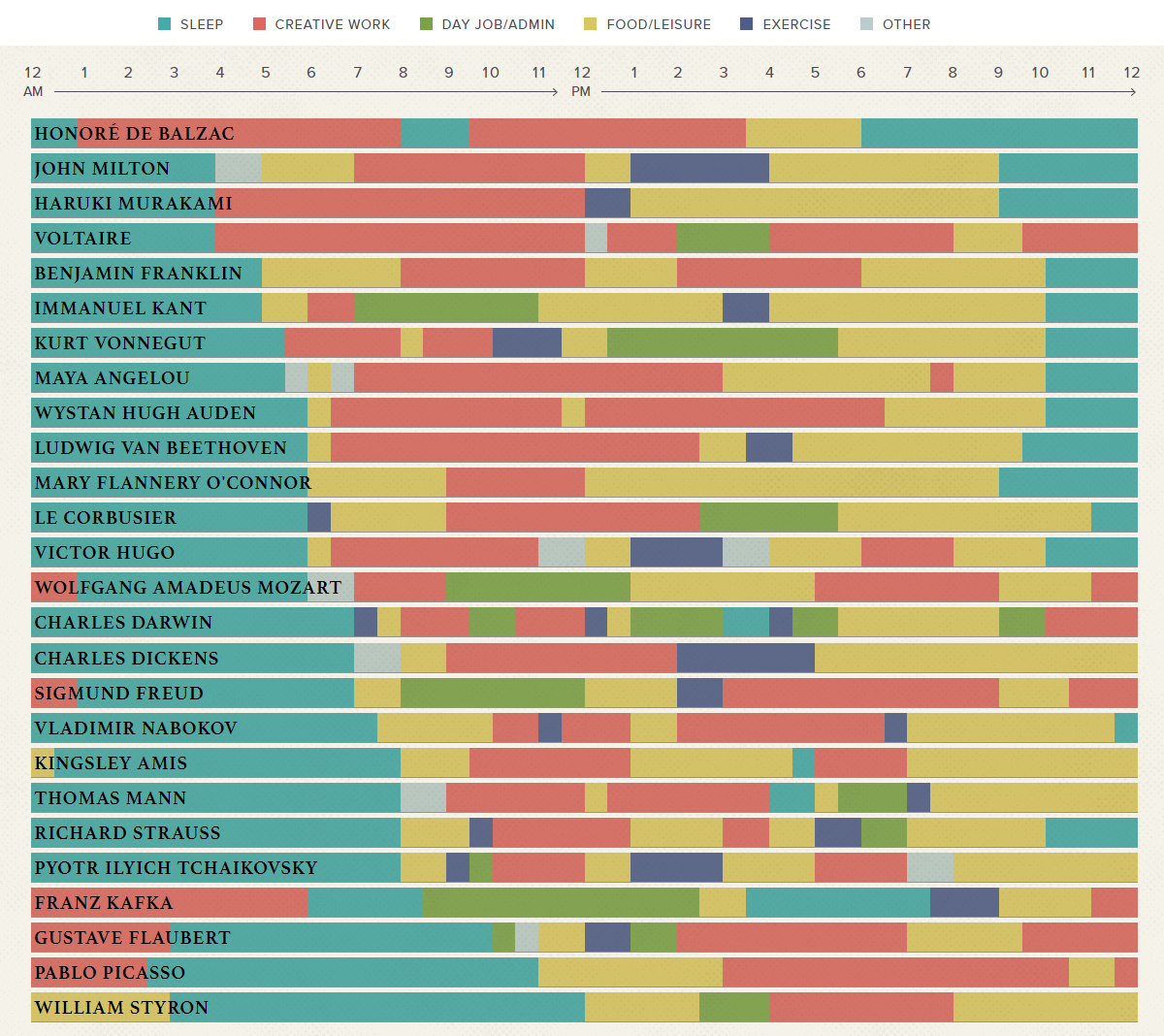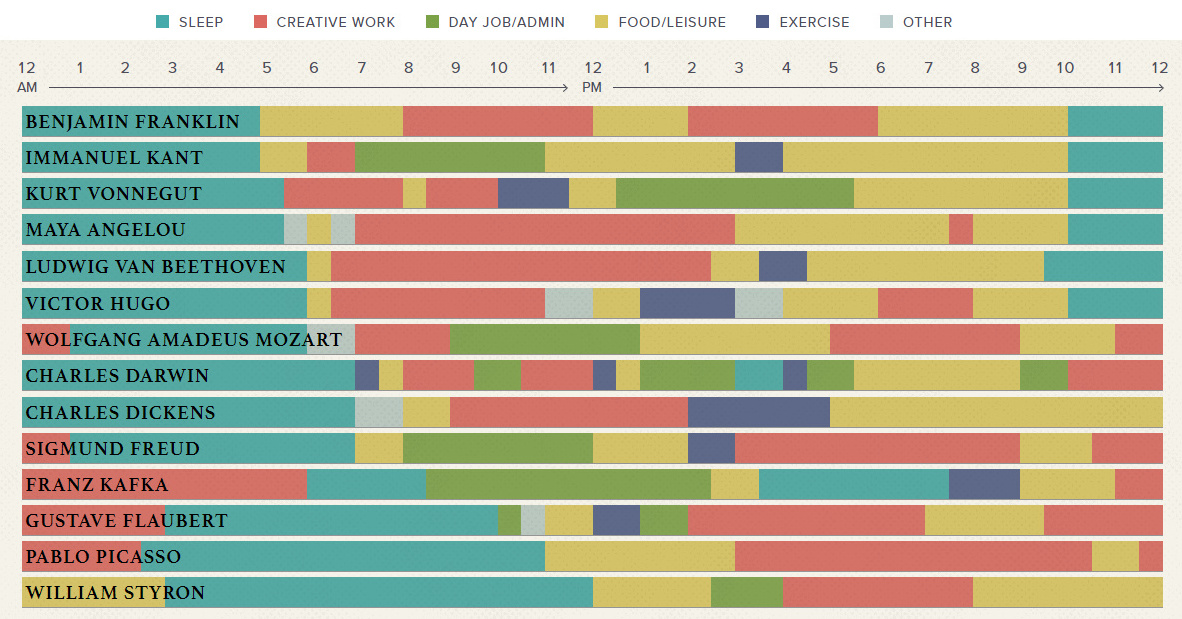Misc
Visualizing the Daily Routines of Famous Creative People

Visualizing the Daily Routines of Famous Creative People
Creative people have a reputation for circumventing convention.
After all, if creatives always did things the same way as everyone else, how could they ever produce anything original and truly unique?
While it’s not always easy to do things differently, the most famous creative people throughout history have almost always followed their own paths. The end result, thankfully for us, is a wealth of original art that has served to inspire generation upon generation.
Time Well Spent
Today’s chart comes to us from Podio and it breaks down the daily routines of famous creative people, such as Pablo Picasso, Mozart, Maya Angelou, or Benjamin Franklin.
We highly recommend the interactive version which allows you to highlight segments of the chart to see more specific details on the routines of each creative person.
It’s also worth noting that the routines listed don’t necessarily represent the exact everyday activities for the listed creatives – instead, they are representations of what’s been recorded in diaries, journals, letters, or other literature by these greats themselves.
Finally, most of the data comes from the book Daily Rituals: How Artists Work by Mason Currey.
Unconventional Habits of Creative Geniuses
Here are some of the creatives that had some of the most unusual and eccentric routines:
Ludwig van Beethoven
The famous German composer and pianist was a coffee addict, and would count exactly 60 beans for each cup of joe he consumed.
Franz Kafka
The novelist would have strong bouts of insomnia and often hallucinated. This condition shaped his creative process, and he stated in his journal that he only knew the type of writing in which “fear [kept him] from sleeping”.
Honoré de Balzac
The French novelist and playwright “[went] to bed at six or seven in the evening, like the chickens” and started working just after midnight. When he worked, he wore “Moroccan slippers” and a “notorious white monkish robe with a belt of Venetian gold”. In his defense, with this type of routine, he was able to write 85 novels in 20 years.
W.H. Auden
The English-American poet took Benzedrine – an amphetamine – every morning for 20 years as a systematic part of his routine and creative process. He balanced its use with the barbiturate Seconal, for when he wanted to sleep. He called amphetamines a “labor-saving device” that gave direct energy to his work.
Victor Hugo
The French poet, novelist, and dramatist, best known for penning Les Misérables and The Hunchback of Notre-Dame, had very busy and eclectic days.
His breakfast would include coffee and two raw eggs, and after working for a few hours in the morning, he would take an ice bath on the roof. In the afternoon, he would try to fit in a quick visit with his barber, a date with his mistress, and also some strenuous exercise. In the evening, he would write some more, and then play cards and go out with friends.
The Reputation Lives On
Rightfully or wrongfully deserved, the reputation of creative geniuses for doing things differently is something that will likely continue to live on – and the rest of the world will likely pass judgement so long as they continue to receive the fruits of their labors.
Misc
How Hard Is It to Get Into an Ivy League School?
We detail the admission rates and average annual cost for Ivy League schools, as well as the median SAT scores required to be accepted.

How Hard Is It to Get Into an Ivy League School?
This was originally posted on our Voronoi app. Download the app for free on iOS or Android and discover incredible data-driven charts from a variety of trusted sources.
Ivy League institutions are renowned worldwide for their academic excellence and long-standing traditions. But how hard is it to get into one of the top universities in the U.S.?
In this graphic, we detail the admission rates and average annual cost for Ivy League schools, as well as the median SAT scores required to be accepted. The data comes from the National Center for Education Statistics and was compiled by 24/7 Wall St.
Note that “average annual cost” represents the net price a student pays after subtracting the average value of grants and/or scholarships received.
Harvard is the Most Selective
The SAT is a standardized test commonly used for college admissions in the United States. It’s taken by high school juniors and seniors to assess their readiness for college-level academic work.
When comparing SAT scores, Harvard and Dartmouth are among the most challenging universities to gain admission to. The median SAT scores for their students are 760 for reading and writing and 790 for math. Still, Harvard has half the admission rate (3.2%) compared to Dartmouth (6.4%).
| School | Admission rate (%) | SAT Score: Reading & Writing | SAT Score: Math | Avg Annual Cost* |
|---|---|---|---|---|
| Harvard University | 3.2 | 760 | 790 | $13,259 |
| Columbia University | 3.9 | 750 | 780 | $12,836 |
| Yale University | 4.6 | 760 | 780 | $16,341 |
| Brown University | 5.1 | 760 | 780 | $26,308 |
| Princeton University | 5.7 | 760 | 780 | $11,080 |
| Dartmouth College | 6.4 | 760 | 790 | $33,023 |
| University of Pennsylvania | 6.5 | 750 | 790 | $14,851 |
| Cornell University | 7.5 | 750 | 780 | $29,011 |
*Costs after receiving federal financial aid.
Additionally, Dartmouth has the highest average annual cost at $33,000. Princeton has the lowest at $11,100.
While student debt has surged in the United States in recent years, hitting $1.73 trillion in 2023, the worth of obtaining a degree from any of the schools listed surpasses mere academics. This is evidenced by the substantial incomes earned by former students.
Harvard grads, for example, have the highest average starting salary in the country, at $91,700.
-

 Real Estate2 weeks ago
Real Estate2 weeks agoVisualizing America’s Shortage of Affordable Homes
-

 Technology1 week ago
Technology1 week agoRanked: Semiconductor Companies by Industry Revenue Share
-

 Money2 weeks ago
Money2 weeks agoWhich States Have the Highest Minimum Wage in America?
-

 Real Estate2 weeks ago
Real Estate2 weeks agoRanked: The Most Valuable Housing Markets in America
-

 Business2 weeks ago
Business2 weeks agoCharted: Big Four Market Share by S&P 500 Audits
-

 AI2 weeks ago
AI2 weeks agoThe Stock Performance of U.S. Chipmakers So Far in 2024
-

 Misc2 weeks ago
Misc2 weeks agoAlmost Every EV Stock is Down After Q1 2024
-

 Money2 weeks ago
Money2 weeks agoWhere Does One U.S. Tax Dollar Go?




